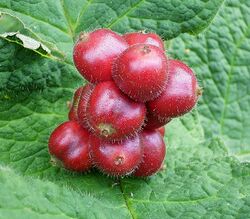Biology:Triosteum
| Triosteum | |
|---|---|

| |
| Triosteum himalayanum fruits | |
| Scientific classification | |
| Kingdom: | Plantae |
| Clade: | Tracheophytes |
| Clade: | Angiosperms |
| Clade: | Eudicots |
| Clade: | Asterids |
| Order: | Dipsacales |
| Family: | Caprifoliaceae |
| Subfamily: | Caprifolioideae |
| Genus: | Triosteum L. |


Triosteum, commonly known in American English as horse-gentian[1] or, less commonly, feverwort, and, in Standard Chinese as 莛子藨属 (Script error: The function "transl" does not exist.), is a genus of flowering plants belonging to the family Caprifoliaceae. A genus of six species in total, it has three species native to North America, and three more in eastern Asia.
Derivation of Genus Name
The name Triosteum is a compound of the Greek tria 'three' and osteon 'bone', in reference to the three hard pyrenes ( pips / pits ) in each drupe ( berry ) - giving the meaning 'having three pits ( as hard as ) bone'.[2]
Description
Triosteum spp. are perennial, herbaceous plants of rich woods. Each plant typically consists of at least one erect, round, hairy, fistular stem, 1 to 4 feet (0.3 to 1.2m) high, with opposite ovate-lanceolate entire leaves, and whitish to purplish flowers presented either in axillary whorls or terminal racemes. The fruit is a drupe.[3] It may be white, yellow, orange, or red, depending on the species.
Species
Five species and one variety are currently accepted by The Plant List,[4] and a sixth species by the Online Flora of China:[5]
- Triosteum angustifolium L. - yellowfruit horse-gentian, Native to the eastern United States
- Triosteum aurantiacum E.P. Bicknell - orangefruit horse-gentian, native to the eastern United States
- Triosteum aurantiacum var. illinoense ( Wiegand ) E.J. Palmer & Steyerm. ( named for the U.S. state of Illinois ).
- Triosteum himalayanum Wallich. - 穿心莛子藨 chuan xin ting zi biao, native to China, Bhutan, Nepal, and India[6] N.B. Species name listed as 'Invalid' by The Plant List (-see note below ).
- Triosteum perfoliatum L. - feverwort, Native to the eastern United States
- Triosteum pinnatifidum Maxim., 莛子藨 ting zi biao, native to China and Japan[7]
- Triosteum sinuatum Maxim., 腋花莛子藨 ye hua ting zi biao, native to east Asia[8]
N.B. A problem exists in relation to the name Triosteum himalayanum Wallich., which has been applied to a specimen of the ( unrelated ) Lasianthus hirsutus belonging to the genus Lasianthus of the family Rubiaceae : see link below to species pages in Online Flora of China 'Triosteum himalayanum ' and 'Lasianthus hirsutus'.
Ornamental Value
Certain species in the genus are sometimes cultivated for their colorful fruits, although the plants have been characterised as 'somewhat weedy perennials' and their flowers are, in general smaller and less showy than those of the related genus Lonicera, the Honeysuckles.[9]
Uses
American species : the dried and roasted fruits have been occasionally used as a substitute for coffee; but they are chiefly valued for their medicinal properties, the roots having been used as an emetic and mild cathartic. The drug is sometimes called Tinker's root, after Dr. Tinker, who first brought it to notice.[10]
Asiatic species : The ripe fruits of Triosteum himalayanum Wallich. have been used for 'blood purification' in the Himalayas.[10] The concept of a medicinal plant that 'purifies the blood' is not one recognised by modern medicine, although the effects of plants believed in folk medicine and more recently in alternative medicine to possess such a property are often cholagogue, laxative and / or diuretic.[11][12]
Chemistry
Five monoterpene indole alkaloids (vincosamide-6′-O-β-d-glucopyranoside (1), vincosamide (2), strictosamide (3), strictosidine (4), and 5(S)-5-carboxystrictosidine (5)), two monoterpene diglycosides ( see Glycoside ) (urceolide (6) and 4(S)-4-hydroxyurceolide (7))[13] and 10 iridoids, ( triohimas A–C, naucledal, secologanin dimethyl acetal, grandifloroside, sweroside, loganin, vogeloside and (E)-aldosecologanin ) have recently been isolated from the roots of Triosteum pinnatifidum Maxim. Most of the iridoids in question were derived from loganin or secologanin with a glucose moiety at C-1 position and these findings indicate a close relationship between the genera Triosteum and Lonicera, and support the viewpoint that the iridoids derived from loganin or secologanin could be considered chemotaxonomic markers for the family Caprifoliaceae.[14]
References
- ↑ "Triosteum". Natural Resources Conservation Service PLANTS Database. USDA. https://plants.usda.gov/core/profile?symbol=TRIOS. Retrieved 15 December 2015.
- ↑ Linnaeus, Carl Species Plantarum 1: 176. 1753.
- ↑ Jacobs, B.; Lens, F.; Smets, E. (2009), "Evolution of fruit and seed characters in the Diervilla and Lonicera clades (Caprifoliaceae, Dipsacales)", Annals of Botany 104 (2): 253–276, doi:10.1093/aob/mcp131, PMID 19502353
- ↑ "Search for 'Triosteum'". http://www.theplantlist.org/tpl1.1/search?q=Triosteum.
- ↑ Gould, K. R., Donoghue, M. J. (2000). "Phylogeny and biogeography of Triosteum (Caprifoliaceae)". Harvard Papers in Botany 5 (1): 157–166. http://www.phylodiversity.net/donoghue/publications/MJD_papers/2000/096_Gould_HarPapBot00.pdf.
- ↑ Yang, Qiner; Landrein, Sven; Osborne, Joanna; Borosova, Renata, "Triosteum himalayanum", Flora of China, 19, http://www.efloras.org/florataxon.aspx?flora_id=2&taxon_id=200022407
- ↑ Yang, Qiner; Landrein, Sven; Osborne, Joanna; Borosova, Renata, "Triosteum pinnatifidum", Flora of China, 19, http://www.efloras.org/florataxon.aspx?flora_id=2&taxon_id=200022408
- ↑ Yang, Qiner; Landrein, Sven; Osborne, Joanna; Borosova, Renata, "Triosteum sinuatum", Flora of China, 19, http://www.efloras.org/florataxon.aspx?flora_id=2&taxon_id=200022409
- ↑ The Royal Horticultural Society Dictionary of Gardening ed. Chittenden, Fred J., 2nd edition, by Synge, Patrick M. Volume IV : Pt-Zy Pub. Oxford at the Clarendon Press 1965. Reprinted 1984. ISBN:0-19-869106-8 p.2149.
- ↑ 10.0 10.1 Quattrocchi, Umberto (2012). CRC World dictionary of medicinal and poisonous plants: common names, scientific names, eponyms, synonyms and etymology. Volume V R-Z. CRC Press Taylor and Francis Group. pps. 636-7.
- ↑ Re. pseudoscientific notion of 'blood purification' http://www.dcscience.net/2007/06/24/so-what-is-a-blood-cleanser-quinion-speaks/ retrieved 4.16pm on 2/5/18.
- ↑ https://sciencebasedmedicine.org/detox-what-they-dont-want-you-to-know/ retrieved 4.27pm on 2/5/18.
- ↑ Chai,Xin, Su,Yan-Fang, Yan,Shi-Lun, Huang,Xiong Chemical Constituents of the Roots of Triosteum pinnatifidum Chemistry of Natural Compounds 50(6) November 2014. https://www.researchgate.net/publication/278397408_Chemical_Constituents_of_the_Roots_of_Triosteum_pinnatifidum Retrieved 11.20am on 4/5/18
- ↑ Chai,Xin, Su,Yan-Fang, Zheng,Yunhui and Gao,Xiu-Mei Iridoids from the roots of Triosteum pinnatifidum Biochemical Systematics and Ecology 38(2):210-212.April 2010.https://www.researchgate.net/publication/247039524_Iridoids_from_the_roots_of_Triosteum_pinnatifidum Retrieved 11.16am on 4/5/18
External links
Wikidata ☰ Q3312339 entry
 |

